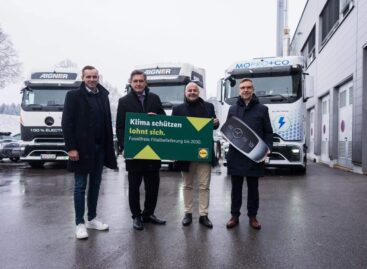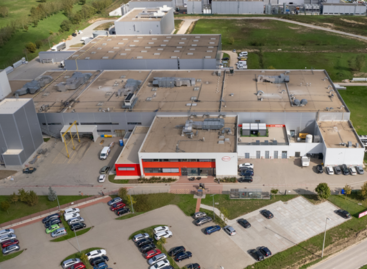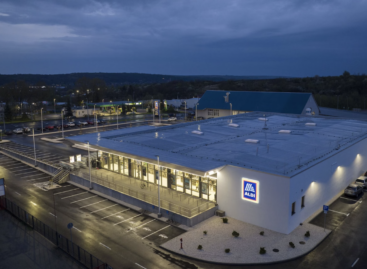CSAOSZ conference: reducing food loss via sustainable packaging
The National Association of Packaging and Materials Handling (CSAOSZ) has been the first in Central Europe to organise an international conference on the role of sustainable packaging in preventing food waste.
This article is available for reading in Trade magazin 2024/6-7
Dr Olga Felkai Beáta, deputy state secretary for food industry and trade policy of the Ministry of Agriculture opened the event. She stressed that reducing food waste and thus unnecessary environmental impact is an important part of the government’s programme. She highlighted FAO’s food security and nutrition guidelines and placed particular emphasis on the Farm to Fork (2020) strategy of the European Union.
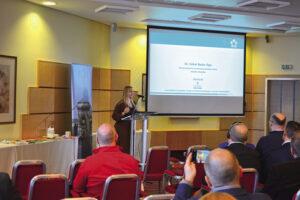
Dr. Beáta Olga Felkai, deputy state secretaryof the Ministry of Agriculture highlighted FAO’s food security and nutrition guidelines
Aleksa Mirkovic from the United Nations Industrial Development Organisation (UNIDO) spoke about the Save Food initiative, which has now become a global programme, its educational and awareness-raising context, and gave participants an insight into the details of the cooperation with the World Packaging Organisation (WPO) in this domain.
No Leftovers
Nerida Kelton, vice president of the World Packaging Organisation introduced the “Save Food Packaging” initiative, which seeks to launch packaging solutions along the value chain that minimise food loss. She told that 1.3 billion tonnes of food is wasted globally every year, while 800 million people go hungry and more than 100 million people are at risk of starvation due to severe malnutrition, particularly in developing countries.
Dr Gyula Kasza, head of the risk prevention and education department at the National Food Chain Safety Office (NÉBIH) gave a presentation on food waste related experiences in Hungary and the results of surveys on the topic. He pointed out that from the food already prepared for consumption, 17% goes to waste in the retail, catering and household sectors, from which 61% is household waste, 26% comes from catering and 13% is retail waste. Dr Kasza outlined the main aspects of the No Leftovers programme launched by NÉBIH.
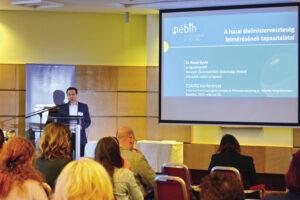
Dr. Gyula Kasza, head of the risk prevention and education department at NÉBIH gave a presentation on food waste related experiences in Hungary
Benefits of the right packaging
Nerida Kelton stepped on the podium once again to showcase the best examples of innovative and intuitive packaging techniques that contribute to reducing food waste. She brought case studies on the effective use of packaging technology, including hermetically sealed bags for storing corn in Kenya and time-temperature indicators helping to monitor food freshness.
The last speaker in the morning section of the conference was Miklós Nagy, technical secretary of CSAOSZ, who shared his thoughts on identified food loss sources and packaging solutions. He underlined that packaging has a big impact on the shelf life of food. According to a study, packaged broccoli stays fresh for 36 days, while unpackaged broccoli remains fresh for only 15 days. There is another benefit of packaging: lower CO2 emissions.
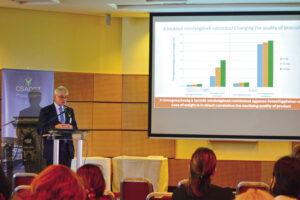
Miklós Nagy, technical secretary of CSAOSZ shared his thoughts on identified food loss sources and packaging solutions
Innovative solutions
Following a lunch break and presenting CSAOSZ’s “For the Trade” and “For Progress in the Packaging Industry” awards, GS1 Hungary Nonprofit Zrt.’s CEO Dávid Kétszeri talked about the role of GS1 standards in preventing food loss. He explained that GS1 standards are used to scan 10 billion barcodes every day, more than 2 billion products have GS1 barcodes and more than 2 million companies use the standards.
Mónika Hindiné Ódor, managing director of Starfol Plusz Kft. spoke to conference participants about the role of mono-material sustainable packaging, and the role of these materials in the vacuum and modified atmosphere packaging of food products. The next speaker was Károly Orbán, chairman of the board of CODEX Zrt., who gave participants an insight into single- and multilayer labels.
In a maze of rules
At the end of the conference, Beáta Gönci from CSAOSZ and Katalin Kecskés from GS1 reviewed the new environmental regulations affecting domestic packaging, with a special focus on the environmental protection product fee (EPF), extended producer responsibility (EPR), the deposit refund scheme (DRS) and single-use plastics (SUP). The joint presentation also covered the topic of GTIN identification and the EAN-13 barcode, which are very important in identifying and tracking products in the drink container return system. //
Packaging solutions offering long freshness

Julius Mazan
Innovation Manager
Smurfit Kappa
“In food packaging the right combination of packaging techniques and materials is key in reducing waste. However, the shift towards sustainability is increasingly driving packaging solutions towards simpler, mono-materials, with the help of special gas-containing packaging. For example in fruit packaging the addition of certain gases can significantly prolong the freshness of food”,
explains Julius Mazan, innovation manager of Smurfit Kappa. //
Related news
Too many gifts, too much food: our holiday excesses are putting a serious strain on the environment
🎧 Hallgasd a cikket: Lejátszás Szünet Folytatás Leállítás Nyelv: Auto…
Read more >Lidl Austria Expands Electric Supply Fleet
🎧 Hallgasd a cikket: Lejátszás Szünet Folytatás Leállítás Nyelv: Auto…
Read more >Henkel: 3,000 accident-free days
🎧 Hallgasd a cikket: Lejátszás Szünet Folytatás Leállítás Nyelv: Auto…
Read more >Related news
Even though the price of cocoa has halved, chocolate will not become cheaper
🎧 Hallgasd a cikket: Lejátszás Szünet Folytatás Leállítás Nyelv: Auto…
Read more >Temu is crushing domestic webshops – Christmas won’t change either
🎧 Hallgasd a cikket: Lejátszás Szünet Folytatás Leállítás Nyelv: Auto…
Read more >The Hungarian Food Bank is putting together 44,000 food packages from the proceeds of ALDI’s first Advent market
🎧 Hallgasd a cikket: Lejátszás Szünet Folytatás Leállítás Nyelv: Auto…
Read more >

